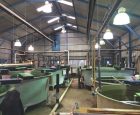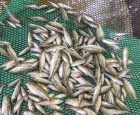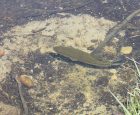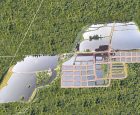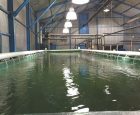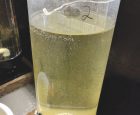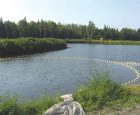
Features
Profiles
Turning pits into profits
With its frigid winters and abundant cold lakes and streams Canada’s finfish industry is dominated by the culture of trout and salmon. However, in the heart of central Ontario lies the small town of Zephyr, where a small company is rearing non-traditional species in a non-traditional way.
July 18, 2018 By Ron Hill
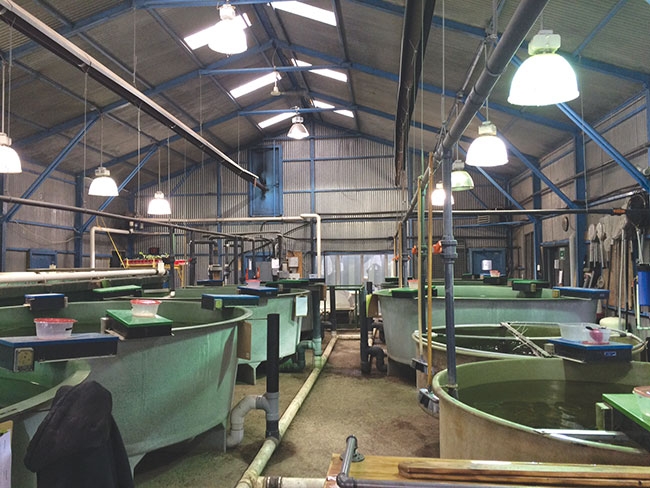 Early rearing area. With its frigid winters and abundant cold lakes and streams
Early rearing area. With its frigid winters and abundant cold lakes and streamsZephyr Peat Land Harvesting sells soil products specializing in peat and peat blends. Peat is harvested by excavating the surface peat deposits from old marshlands. These excavations create pits that, because of the excessive ground water, turn into ponds. Finding himself with an ever-increasing number of ponds, in 2013 owner Bruce Blacktopp launched Zephyr Fish Farm.
Plethora of ponds
After harvesting peat for 27 years there are currently 70 ponds, with 10 to 12 more added each year. All ponds are 12-feet deep and are now purpose-built with fish farming in mind. Ledges are built into the walls of the ponds to help facilitate netting operations. Breeding ponds are built with plateaus to act as spawning areas for bass.
Because they come from peat marshes, the ponds are filled with ground water which infiltrates through the soil into the ponds and not from a stream, well, lake or traditional water source. There is no flow or water exchange and no aeration.
Species selection and operations at Zephyr fish farm are geared to take advantage of this unique and potentially problematic design. Traditional species to the region, like trout, would not perform well in the stagnant ponds. A warmer water species, specifically large mouth bass which can tolerate much lower dissolved oxygen levels and much higher water temperatures were identified as the species to be cultured in this setup.
Densities in the ponds must be kept low to avoid oxygen issues but the large number of ponds allow for a large standing biomass. Some ponds are designated for baitfish growth – fathead minnows and golden shiners – which are reared and added as forage for production fish. All fish are transferred from the pond the old-fashion way: Staff use seines, traps and fyke nets to collect fish for transport.
Related: Making old new again
Large Mouth Bass
Large Mouth Bass was identified as the most marketable species that could be cultured under Zephyr Fish Farm’s unique operating circumstances and is the focus of the operation. Market size fish (550-750g) are sold live to fish markets in nearby large urban centres. Large Mouth Bass are desirable in Asian communities in the greater Toronto area, which are traditionally supplied by fish hauled from the central and southern United States.
Bass are allowed to spawn naturally in the ponds. They are nest builders, and in the spring the male will build and guard a solitary nest on any firm substrate in the shallows. A few weeks after hatch the fry begin to school. They are collected and put into specialized grow-out ponds or transferred to the hatchery. Ponds are fertilized ahead of time to provide food for the young fry. Fry that are moved to the hatchery are pellet trained.
“Pellet training is pretty easy for us and the bass take to it easily now. Once they are pellet trained here in the hatchery we can transfer them out to one of the grow-out ponds, where they can forage and have their diet supplemented with pellets,” said Zephyr Fish Farm manager Russ Enslow.
“We move juveniles through the hatchery, get them graded on feed, then get them back out in the ponds.”
As this happens some fish are kept in the hatchery for longer periods. Hatchery water temperatures and feeding allow the bass kept in the hatchery to grow faster than the same cohort in the ponds. This causes production lots to be staggered to allow for more frequent harvesting of bass throughout the year.
The recirculating hatchery has small circular tanks for pellet training and accelerated growth, and a raceway used for large mouth bass grow-out. The hatchery is fed by the 40-acre Joseph’s Lake, created by the original peat excavation in the 1980s. The lake isn’t used for commercial rearing but the water is used to supply the hatchery and pump water into ponds.
Because they are kept at low density and pellet trained, Zephyr’s bass have diminished cannibalistic tendencies. Supplied with adequate forage fish and supplemented with pellets, the bass survive well in the ponds. Nothing is added to the ponds in winter and the fish overwinter without feed or supplement.
Fish are moved from the ponds back into the hatchery raceway for final grow-out. Market size is 550-750g, depending on the time of year. Like many places doing large mouth bass grow-out, Zephyr is facing challenges when their size reaches 400 grams in the tanks and raceway. Grow-out tends to slow and fish performance falls.
“Finding the right diet has been a challenge at this stage, as has been filtration,” Enslow says. “There are a lot of diets out there but very few formulated for large mouth bass. We have switched commercial diets several times and are trying to find the one that performs best for us.”
The nature of the water in the lake with its high organic loads has been the biggest early challenge to overcome. By diversifying the diet and increasing filtration capacity, Zephyr is looking to streamline their bass-growing process in the next several years.
Walleye and perch
Zephyr also maintains walleye and perch stocks, which are mainly sold as fingerlings for pond stocking. One hundred and fifty pellet-trained walleye brood are spawned each year. Eggs are incubated in bell jars and fry are added to fertilized ponds. To collect the brood, water from the main lake is pumped into a pond for several days. The spawning walleye congregate around the flowing water after a few days and can be netted. Yellow perch are maintained in several ponds and sold for pond stocking. Because of their prolific nature, they are allowed to spawn naturally in the ponds. Both species are collected and pellet trained in the hatchery once the fry reach the appropriate size.
“Right now, our focus is large mouth bass because there is a market for it. If the market was there we could easily supply pellet-trained walleye or perch fingerlings for grow-out and gear more towards the demand,” says Enslow.
Zephyr Expansion
Fish operations started at Zephyr in 2014. It has been four years of refining practices, of trial and error, and of deciding what species perform the best. In 2017, Zephyr started its hatchery expansion project to increase filtration, water treatment and increase large mouth bass grow-out capacity.
The addition of two new drum filters and an expanded biofilter will allow Zephyr to increase bass grow-out capacity and speed. Large holding tanks are being added to the new building for staging market size fish.
With the fish ponds readily stocked and bass available for grow-out, bringing the expansion online should push Ontario’s only bass producer to maintain a steady supply of Canadian-raised bass for the Canadian market.
Pond potential
Peat forms over centuries as partially decayed vegetation builds up faster than it decomposes. This mass of partially decayed vegetation is peat and it is unique to peatlands and certain wetlands. The peat is harvested by draining the land and excavating the peat. Ontario peat is desired for mushroom culture as well as by greenhouses and nurseries. Carex peat, which Zephyr harvests, has a neutral pH, which doesn’t affect the ponds as many types of peat would.
When he bought Zephyr Peat Land Harvesting in 1991, Bruce Blacktopp quickly realized that along with a successful peat business, he now owned a significant amount of ponds. In 2011, Blacktopp started Zephyr Fish Farm and purchased a small Ontario hatchery giving him the tanks, equipment and building that allowed for operations to commence.
Print this page
